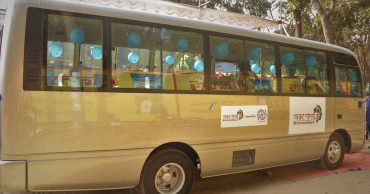children with disabilities
Majority of children with disabilities are not enrolled in any formal education: Survey
More than half of children with disabilities in Bangladesh are not enrolled in any formal education, according to new national-level data revealed on Tuesday.
The findings come from the recently-published National Survey on Persons with Disabilities (NSPD) 2021, conducted by the Bangladesh Bureau of Statistics (BBS) with technical support from UNICEF.
The survey reveals that among children with disabilities (aged 5-17 years), only 65 per cent are enrolled in primary school and only 35 per cent are enrolled in secondary school. In total, 60 percent of children with disabilities aged 5-17 years are not in education.\
Read more: Learning Disabilities in Children: Types, symptoms, ways to help
The survey also found that children with disabilities who do attend formal education lag behind academically by over two years for their age on average.
“The data from this national survey – the first of its kind by the BBS – highlights the challenges children with disabilities face growing up. The findings will support the Government to formulate policies and initiatives to ensure the rights of persons with disabilities in Bangladesh,” said Iftekhairul Karim, Project Director, BBS.
According to the survey, 1.7 percent of children in Bangladesh live with one of the twelve types of disability defined in the Persons with Disability Rights and Protection Act 2013, while 3.6 per cent of children face functional difficulty in at least one of the domains of seeing, hearing, walking, fine motor skills, communication, learning, playing or controlling behaviour.
“The new data highlights just how many children with disabilities in Bangladesh are losing out on education. We need to do more for these children. We need to provide the support and services they need, and we need to create an inclusive environment where they can thrive,” said Sheldon Yett, UNICEF Representative to Bangladesh.
Data from the survey also shed light on the difficulties that children with disabilities face as adults.
Read more: Youth with disabilities deprived of learning, employment scopes: Study
Only one third of persons with disabilities of working age are employed, with women with disabilities far more likely to be unemployed compared to men.
And while 90 percent of persons with disabilities who are registered with the Government receive disability allowances, the vast majority of them – about 65 per cent – remain unregistered.
Early identification and management of childhood disabilities are critical to maximizing the potential of children.
It is also critical to create an inclusive environment where families and service-providers can support children with disabilities to participate actively in all spheres of life.
UNICEF works with the government and partners in Bangladesh to champion the rights of children with disabilities to education, healthcare and future employment, and to remove social stigma and prejudice.
2 years ago
Nearly 240 mn children with disabilities around world: UNICEF
The number of children with disabilities globally is estimated at almost 240 million, according to a new UNICEF report.
Children with disabilities are disadvantaged compared to children without disabilities on most measures of child well-being, the report says on Wednesday.
Read: Covid-19 puts future of 37 mn children in Bangladesh at risk: UNICEF, UNESCO
“This new research confirms what we already knew: Children with disabilities face multiple and often compounding challenges in realizing their rights,” said UNICEF Executive Director Henrietta Fore.
“From access to education, to being read to at home; children with disabilities are less likely to be included or heard on almost every measure. All too often, children with disabilities are simply being left behind.”
The report includes internationally comparable data from 42 countries and covers more than 60 indicators of child well-being – from nutrition and health, to access to water and sanitation, protection from violence and exploitation, and education.
These indicators are disaggregated by functional difficulty type and severity, child’s sex, economic status, and country.
The report makes clear the barriers children with disabilities face to participating fully in their societies and how this often translates to negative health and social outcomes.
Read: Covid-19 put future of 800 mn children across Asia at risk: UNICEF, UNESCO
“Inclusive education cannot be considered a luxury. For far too long, children with disabilities have been excluded from society in a way that no child ever should be. My lived experience as a woman with disabilities supports that statement,” says Maria Alexandrova, 20, a UNICEF youth advocate for inclusive education from Bulgaria.
“No child, especially the most vulnerable, should have to fight for their basic human rights alone. We need governments, stakeholders and NGOs to ensure children with disabilities have equal, inclusive access to education.”
4 years ago
IOM donates bus for children with disabilities in Cox’s Bazar
The International Organization for Migration (IOM), the UN migration agency, has donated a 30-seat coaster bus to Cox’s Bazar Arunodoy School, a specialised school for children with disabilities, as part of stepped-up efforts to support the host community.
5 years ago




